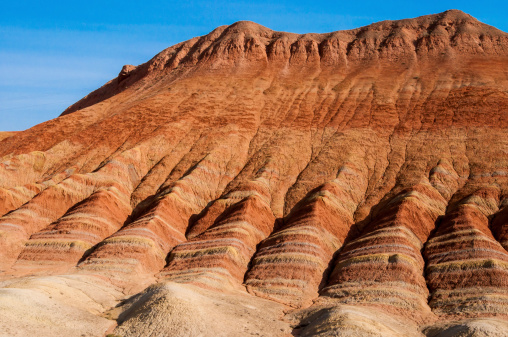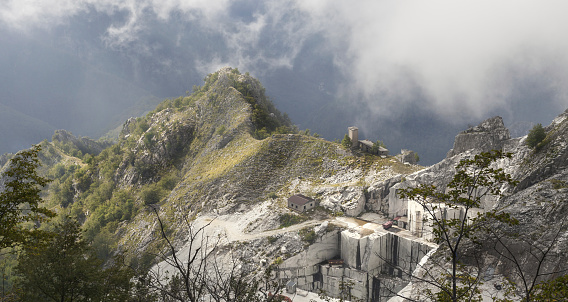Earth is made up of rocks and minerals.
A rock consists of two or more minerals.
Minerals are made of one or more chemicals.
There are three types of rocks: igneous, sedimentary and metamorphic.
The three types of rock
Most mountains are igneous rock called granite. © Getty Images
Igneous rocks
Igneous rocks are formed when volcanoes erupt and liquid rock, called magma, is forced to the surface. When magma cools slowly and hardens inside the Earth’s crust, it forms granite, a very hard rock. Most mountains are made of granite. Other igneous rocks include periodite, obsidian and pumice. Pumice is the only rock that floats.
You can see the layers in this sedimentary rock. Getty Images
Sedimentary rocks
Sedimentary rocks are formed over millions of years. Mountains are worn down by erosion, and rivers and streams wash bits of rock away. This sediment settles in layers at the bottom. Gradually the weight of the layers and mud in lakes and oceans turns into sedimentary rock.
Fossils are often found in sedimentary rocks. Fossils are animals or plants that have died and been quickly covered by sediments (rock and mud) usually on the bottom of a river or other water body. Sedimentary rocks include sandstone, limestone and shale. Over time lots of plants and animals are caught in the layers of sediment and become part of the rock, forming carbon which eventually turns into coal, natural gas or petroleum. These are called fossil fuels.
Marble is a sedimentary rock that has changed into a metamorphic rock. It is cut from the Earth in mines like this. Getty Images
Marble is metamorphic rock. It can be polished and used in buildings. ©Getty Images
Metamorphic rocks
Metamorphic rocks are igneous or sedimentary rocks that have been changed by great heat or pressure due to the movement of the Earth’s crust. Marble is one example of sedimentary rock that has been changed into metamorphic rock.
The Rock Cycle
Over time, the Earth changes a rock from one type to another. It does this using heat, weathering and movement.
Igneous rock can change into sedimentary rock or into metamorphic rock.
Sedimentary rock can change into metamorphic rock or igneous rock.
Metamorphic rock can change into sedimentary rock or igneous rock.
These changes are called the Rock Cycle.
Inside the Earth there is magma, a hot liquid of melted minerals. When magma is forced out of the Earth’s centre, it is called lava. Igneous rock forms inside the Earth’s crust, where the magma cools slowly. It can form above ground, where lava cools quickly.
Wind and water break rock into pieces, and carry them to other places. These pieces, called sediment, drop from the wind or are washed by water to form layers. Over a long period of time, the layers of sediment harden and become sedimentary rock.
The tectonic plates are part of the top part of Earth’s crust. Sometimes they move. When they move, they produce heat. When rock is heated, it does not melt, but it forms crystals. If it already has crystals, then larger crystals are formed. The rock changes, and this change is called metamorphosis. The moving tectonic plates can form mountains. Mountains of metamorphic rocks are broken up and washed away by water to form sediment. This sediment can become new sedimentary rocks.
And the cycle continues.
Here's a video about different kinds of rocks and the rock cycle
Explore educational videos on Earth science at NeoK12






